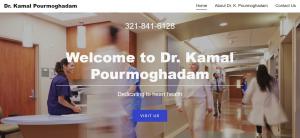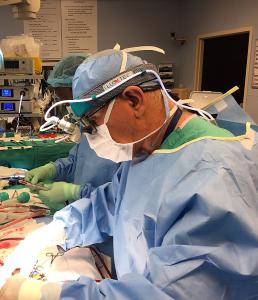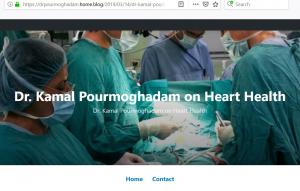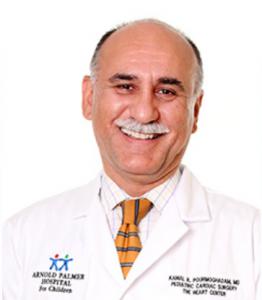Echocardiogram – Overview, Purpose, Advantages, and Limitations explained by Kamal Pourmoghadam, MD in layman's terms
The Echocardiogram is one of the most important tests for diagnosing heart problems. Read the easy-to-understand article by surgeon Kamal Pourmoghadam, MD
Arnold Palmer Hospital for Children (N/A:N/A)
Due to the fact that it provides a lot of information about the structure, size, movement, and functioning of the heart, echocardiogram is one of the essential procedures in the field of cardiology. In order to visualize the movement and functioning of the heart, sound waves are sent to the patient’s heart via a specialized device. As waves reach the heart, they bounce off and create a visual of the heart on a screen. The test can be divided into the following four types:
1. Transthoracic echocardiogram (TTE) – the most commonly performed procedure
2. Stress echocardiogram – performed at two different times, at rest and after performing a physical activity, to identify decreased blood flow and determine the cause of chest pain
3. Doppler echocardiogram
4. Transesophageal echocardiogram
What Is The Purpose Of Echocardiogram?
An echocardiogram is performed to identify any abnormality in the functioning and structure of the heart. The test not only allows cardiologists to examine the anatomy of heart from different angles, but also enables them to observe the heart rhythms. A doctor may prescribe an echocardiogram to patients who complain of constant fatigue for no apparent reason, shortness of breath, and/or fainting. It is also suggested when a doctor suspects structural problems in a patient’s heart, due to the presence of heart murmur.
Advantages of Echocardiogram
An echocardiogram is useful in identifying a number of underlying health conditions, such as:
* Since the test allows the cardiologists to see the movement of heart valves, they can detect any problem in the functioning of heart valves.
* A cardiac echo also helps to evaluate congenital heart disease – a term used for problem in the structure of the heart that is present by birth.
* By assessing the movement of the heart, the test helps to identify if a patient is suffering from cardiac arrhythmia i.e. irregular heart rhythm. It can also help the doctor determine the exact cause of the problem.
* Echo can also help to measure impaired blood flow that happens in certain heart conditions, like aortic stenosis. For that, a special microphone (called Doppler) is used to measure the speed with which the blood is flowing through different parts of the heart.
* The cardiac echo test also helps to measure the effectiveness of different heart treatments. This is done by measuring the left ventricular ejection fraction. Ejection fraction is the comparison of the amount of blood in a heart ventricle at the beginning and the end of a heartbeat. A measuring of ejection fraction helps cardiologists assess the heart’s ability to pump blood.
* Any abnormality in the size and shape of the heart can easily be diagnosed with the help of an echo.
* It also enables doctors to spot any damage in the cardiac tissues, its severity, and exact location.
By helping to identify many underlying heart conditions and their exact causes (in some cases), the echocardiogram procedure enables cardiologists to treat certain heart conditions before they get worse and pose serious health risks. It also helps to design effective treatment plans for patients with existing heart problems as well as to monitor the effects of treatment. The fact that echocardiogram is readily available and does not cost very high makes it a viable diagnostic test in majority of cases.
Limitations of Echocardiogram
Although cardiac ultrasound provides much information about the anatomy and functioning of the heart, it has certain limitations. For example, it does not allow to visualize coronary arteries. This means if there are any blockages in coronary arteries, they cannot be identified via an echocardiogram. Some physical variations, like emphysema (thick chest wall) can also reduce the effectiveness of echocardiogram.
How Long Does an Echocardiogram Take? On average, the echocardiogram procedure takes about an hour.
Bottom Line
Echocardiogram is a highly useful technique and is widely used in the field of cardiology to identify a number of heart issues, their location, and causes. It also helps in determining the effectiveness of certain cardiac treatments. While it has its limitations, the advantages it offers to cardiologists are much greater.
About Dr. Kamal K. Pourmoghadam
Kamal Pourmoghadam, MD, is a pediatric cardiac surgeon at The Heart Center at Arnold Palmer Hospital for Children. He is board certified in general surgery, cardiothoracic surgery and congenital cardiac surgery. Dr. Pourmoghadam earned his bachelor’s degree from University of California, Berkeley, and his medical degree from Albany Medical College in New York. He trained for adult cardiac surgery at the University of Miami, Jackson Memorial Hospital in Miami, and for congenital cardiac surgery at the University of Washington, Seattle Children’s Hospital in Seattle. Dr. Pourmoghadam is a professor of surgery at the University of Central Florida College of Medicine, practicing congenital cardiac surgery for over twenty years and has been active in clinical research. He has extensive experience in neonatal and infant cardiac surgery and has special interest in the repair of single ventricle physiology patients and research in univentricular hearts.
References:
Website: https://kamalpourmoghadam.com
Blog: https://drpourmoghadam.home.blog/
News: https://hippocratesguild.com/dr-kamal-pourmoghadam
News: https://medicogazette.com/dr-kamal-pourmoghadam#425f92ce-0ccc-4fe2-8c31-56cf497704f4
News: https://hype.news/dr-kamal-pourmoghadam/
News report about Dr. Pourmoghadam: http://www.tiogapublishing.com/features/the_marketplace/covington-tot-returns-home-to-pennsylvania-after-lengthy-oklahoma-hospital/article_04865c00-0ae5-11e1-aec8-001cc4c002e0.html
Linkedin: https://www.linkedin.com/in/kamal-pourmoghadam-9a796157/
Dr. Kamal K. Pourmoghadam
Arnold Palmer Hospital for Children
+1 407-255-2164
email us here
Visit us on social media:
LinkedIn
Mayo Clinic Minute: What is heart disease? Heart disease is used interchangeably with the term cardiovascular disease and refers to a variety of conditions.
Legal Disclaimer:
EIN Presswire provides this news content "as is" without warranty of any kind. We do not accept any responsibility or liability for the accuracy, content, images, videos, licenses, completeness, legality, or reliability of the information contained in this article. If you have any complaints or copyright issues related to this article, kindly contact the author above.





